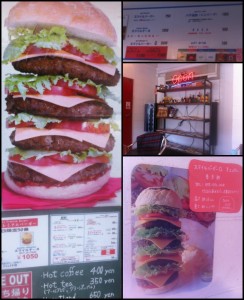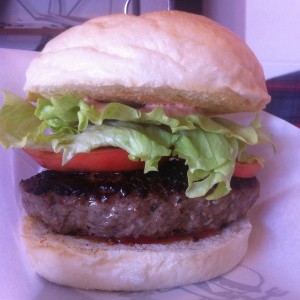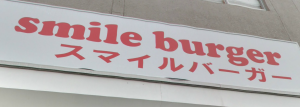The original post can be found here: Smile Burger!
Also, burger lovers in NYC should consider going to BurgerWeekly's "Burgerversary 100" party at Blue Smoke in April. Were I not 12,000 miles away, I'd surely be in attendance. Burgerversary!
The Experience: A hearty 新年快乐 (xin nian kuai le – Happy New Year!) to all of the Little Meisters out there who celebrate the Chinese New Year. After partaking in the New Year’s revelry (which lasts more than a week) for a few days, Burgermeister Josh escaped the firecracker-bombarded streets for the much more tranquil confines of Japan. Thoughts of juicy burgers had taken a temporary backseat to temples and tempura. Until, that is, Josh stumbled upon Smile Burger, a little hole-in-the-wall nestled comfortably amongst the storefronts of a busy thoroughfare in downtown Kyoto. Despite the early hour (it was barely 11 AM), and the fact that hamburgers aren’t exactly on the top of the list of local foods to sample while in Japan, Josh decided to honor his title as Burgermeister and give Smile Burger a try.

The dulcet tones of Avril Lavigne greeted the Burgermeister as he walked into the one room shop, not exactly the artist he expected to hear during his vacation in Japan. The place was tiny, as most establishments are in the Land of the Rising Sun, with only three tables and a take-out counter, behind which the lone proprietor – a young and cheerful Japanese guy – does his burger-flippin’ magic.
The Taste: Burgermeister Josh was initially tempted by the picture of Smile’s “Q Burger”, which appeared to be a quintuple-patty burger stack. However, discretion being the better part of valor (and hoping to save room for more traditional Japanese fare later), he settled on the classic Smile Burger. Josh had walked in hoping that the patty would be made with Kobe beef (this was Japan, after all), but was disappointed, if not unsurprised, to see that it was 100% Australian ground beef, seasoned in salt, pepper, and nutmeg. What the burger lacked in adornments (only lettuce and tomato), it more than made up for in condiments (ketchup, honey mustard, and Thousand Island dressing, all of which were already applied to the burger when it was served). A small portion of pickles and potato chips were served with the Smile Burger, which was presented rather nicely on a wooden board.

Despite somewhat low expectations, Burgermeister Josh was more than a little impressed with the Smile Burger! His initial doubts about the over-saucing of the burger were proven unwarranted, as the Thousand Island and honey mustard combined to create a tart relish flavor, with the ketchup providing its standard tomatoey sweetness. Not to be outdone by the sauces, the sweetness heartiness of the patty itself was readily apparent, the nutmeg in particular emerging in each bite. Josh doesn’t subscribe to the purist notion that burgers should be unadorned with seasoning lest they taste more like meatloaf. The Smile Burger was distinctly sweet and nutmeggy, and, Josh thought, all the better for it.
The Verdict: The Smile Burger had its shortcomings. The meat was slightly overcooked for the Burgermeister’s liking, which he was able to chalk up to his inability to convey his temperature preferences in Japanese. It was also quite greasy, though a burger of all things can be forgiven for a little grease. The pickles and chips that accompanied burger were by no means offensive, but Josh has always been of the opinion that French fries are the only suitable sidekick to a hamburger. These small demerits were not, however, nearly enough to dislodge Josh’s high perception of the Smile Burger. Overall, it was a tastier, more satisfying burger than any of Josh’s middling burger experiences in Shanghai. Shanghai may have glitz and glamour going for it, but, at least with this minimal sample size, Kyoto may indeed have the better of the burger scene!



























